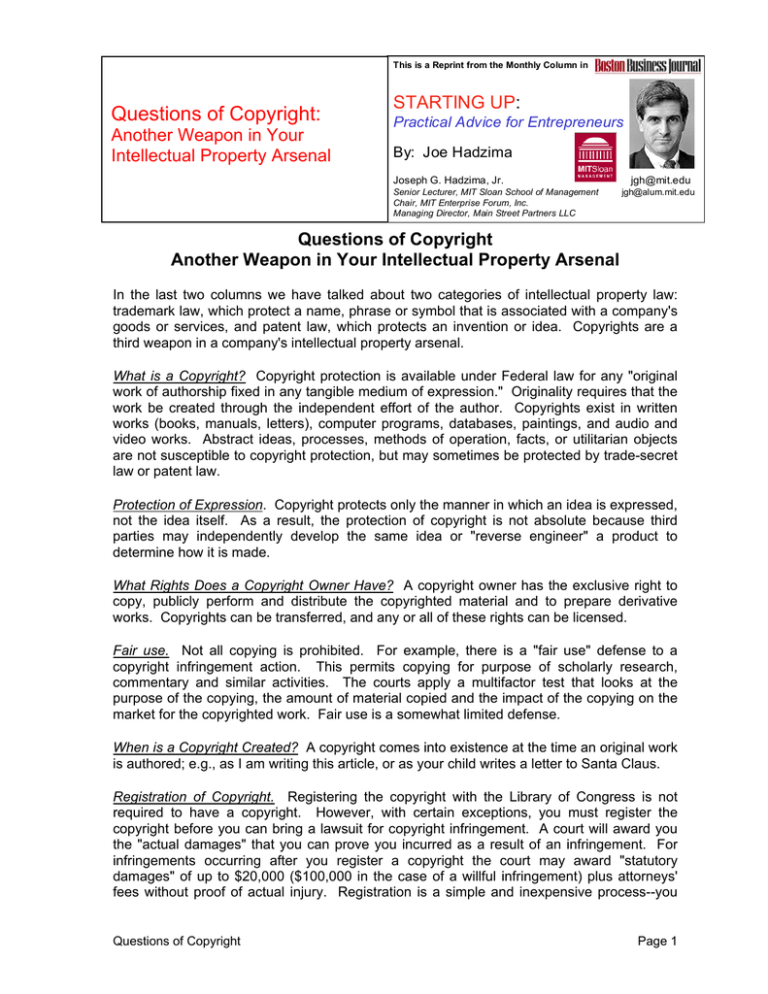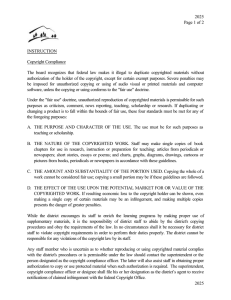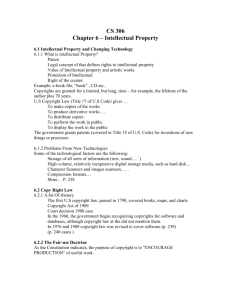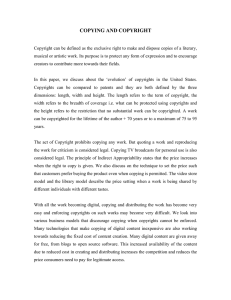
This is a Reprint from the Monthly Column in
Questions of Copyright:
Another Weapon in Your
Intellectual Property Arsenal
STARTING UP:
Practical Advice for Entrepreneurs
By: Joe Hadzima
Joseph G. Hadzima, Jr.
Senior Lecturer, MIT Sloan School of Management
Chair, MIT Enterprise Forum, Inc.
Managing Director, Main Street Partners LLC
jgh@mit.edu
jgh@alum.mit.edu
Questions of Copyright
Another Weapon in Your Intellectual Property Arsenal
In the last two columns we have talked about two categories of intellectual property law:
trademark law, which protect a name, phrase or symbol that is associated with a company's
goods or services, and patent law, which protects an invention or idea. Copyrights are a
third weapon in a company's intellectual property arsenal.
What is a Copyright? Copyright protection is available under Federal law for any "original
work of authorship fixed in any tangible medium of expression." Originality requires that the
work be created through the independent effort of the author. Copyrights exist in written
works (books, manuals, letters), computer programs, databases, paintings, and audio and
video works. Abstract ideas, processes, methods of operation, facts, or utilitarian objects
are not susceptible to copyright protection, but may sometimes be protected by trade-secret
law or patent law.
Protection of Expression. Copyright protects only the manner in which an idea is expressed,
not the idea itself. As a result, the protection of copyright is not absolute because third
parties may independently develop the same idea or "reverse engineer" a product to
determine how it is made.
What Rights Does a Copyright Owner Have? A copyright owner has the exclusive right to
copy, publicly perform and distribute the copyrighted material and to prepare derivative
works. Copyrights can be transferred, and any or all of these rights can be licensed.
Fair use. Not all copying is prohibited. For example, there is a "fair use" defense to a
copyright infringement action. This permits copying for purpose of scholarly research,
commentary and similar activities. The courts apply a multifactor test that looks at the
purpose of the copying, the amount of material copied and the impact of the copying on the
market for the copyrighted work. Fair use is a somewhat limited defense.
When is a Copyright Created? A copyright comes into existence at the time an original work
is authored; e.g., as I am writing this article, or as your child writes a letter to Santa Claus.
Registration of Copyright. Registering the copyright with the Library of Congress is not
required to have a copyright. However, with certain exceptions, you must register the
copyright before you can bring a lawsuit for copyright infringement. A court will award you
the "actual damages" that you can prove you incurred as a result of an infringement. For
infringements occurring after you register a copyright the court may award "statutory
damages" of up to $20,000 ($100,000 in the case of a willful infringement) plus attorneys'
fees without proof of actual injury. Registration is a simple and inexpensive process--you
Questions of Copyright
Page 1
file a short form, pay a very modest fee and deposit a copy of the work. In the case of
computer software there are special rules that allow you to file only a portion of the
computer code. For further information on registration go to the Copyright Office at
http://www.copyright.gov/
Copyright Notice. Prior to 1989, it was necessary to put a copyright notice on a work in
order to obtain a copyright in a published work. This requirement was eliminated when the
United States joined the Berne Convention, the major international copyright regime.
However, you should still use a copyright notice because there are certain benefits that can
be obtained if a notice is used (such as the ability to avoid a "innocent infringer" defense).
The following form is recommended: "Copyright [year of publication], [Name of copyright
owner], All Rights Reserved". The C symbol or the abbreviation "copyr" may be used in
place of the word copyright.
Who Owns a Copyright? In general, the author of an original work is the owner of the
copyright. There are two main exceptions to this rule. First, an employer is the owner of the
copyright on a work created by an employee in the course of his or her employment.
If the creator of a work is not your employee, that person will own the copyright unless the
work is within one of the nine statutory categories of works known as "works for hire" and
there is a written agreement that provides that the work will be owned by the company that
commissions it. Some of "works for hire" categories include a contribution to a collective
work, a translation, a compilation, an instructional text and tests. If the work does not fall
into one of these categories, the only way in which you can obtain ownership of the
copyright is to obtain an assignment in writing from the nonemployee author.
How Long Does a Copyright Exist? Under current law, works copyrighted by an individual
are protected for the life of the author, plus fifty years. Works copyrighted by a business
entity are protected by 75 years from the publication of the work or 100 years from its
creation, whichever expires first. Works copyrighted under older law may be protected for
different periods.
Emerging Issues. Traditional copyright concepts have been put to the test by advances in
computer and information technology. For example, once it was determined that computer
programs were entitled to copyright protection, a series of court cases extended the scope
of copyright protection for computer programs to such an extent that it threatened to protect
the "idea" instead of the "expression". Recently, that trend has started to be reversed.
Multimedia is an emerging area. It combines photography, music, film, text and computer
programs, each of which had its own industry customs for licensing and exploitation of the
rights granted by copyright. Making sure that these rights mesh in a multimedia product can
be a difficult task. In addition, advances in computer technology now enable multimedia
presentations to be created on personal computers rather than in professional studios with
equipment costing hundreds of thousands of dollars. As a result there are many more
persons capable of producing infringing materials.
Copyright issues are looming large on the Information Superhighway. How is the effort of
authors going to be protected and rewarded if it is possible to scan materials into a
computer, and transmit them across the country or around the world in a matter of seconds?
Questions of Copyright
Page 2
I hope you find this overview of copyright law to be helpful. By the way, Boston Business
Journal and I hereby grant you the right to copy and distribute this article, as a whole, so
long as you identify the source and do not charge for it.
DISCLAIMER: This column is designed to give the reader an overview of a topic and is not intended
to constitute legal advice as to any particular fact situation. In addition, laws and their interpretations
change over time and the contents of this column may not reflect these changes. The reader is
advised to consult competent legal counsel as to his or her particular situation.
Questions of Copyright
Page 3





